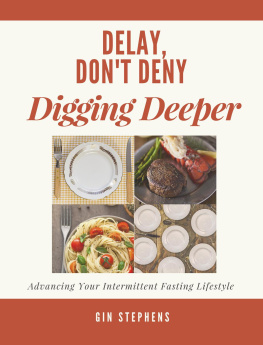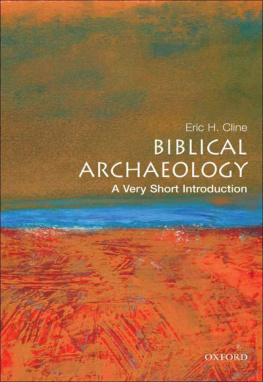Eric H. Cline - Digging Deeper: How Archaeology Works
Here you can read online Eric H. Cline - Digging Deeper: How Archaeology Works full text of the book (entire story) in english for free. Download pdf and epub, get meaning, cover and reviews about this ebook. year: 2020, publisher: Princeton University Press, genre: Romance novel. Description of the work, (preface) as well as reviews are available. Best literature library LitArk.com created for fans of good reading and offers a wide selection of genres:
Romance novel
Science fiction
Adventure
Detective
Science
History
Home and family
Prose
Art
Politics
Computer
Non-fiction
Religion
Business
Children
Humor
Choose a favorite category and find really read worthwhile books. Enjoy immersion in the world of imagination, feel the emotions of the characters or learn something new for yourself, make an fascinating discovery.

- Book:Digging Deeper: How Archaeology Works
- Author:
- Publisher:Princeton University Press
- Genre:
- Year:2020
- Rating:4 / 5
- Favourites:Add to favourites
- Your mark:
- 80
- 1
- 2
- 3
- 4
- 5
Digging Deeper: How Archaeology Works: summary, description and annotation
We offer to read an annotation, description, summary or preface (depends on what the author of the book "Digging Deeper: How Archaeology Works" wrote himself). If you haven't found the necessary information about the book — write in the comments, we will try to find it.
Digging Deeper: How Archaeology Works — read online for free the complete book (whole text) full work
Below is the text of the book, divided by pages. System saving the place of the last page read, allows you to conveniently read the book "Digging Deeper: How Archaeology Works" online for free, without having to search again every time where you left off. Put a bookmark, and you can go to the page where you finished reading at any time.
Font size:
Interval:
Bookmark:

DIGGING DEEPER
DIGGING DEEPER
How Archaeology Works
ERIC H. CLINE
PRINCETON UNIVERSITY PRESS
PRINCETON AND OXFORD
Copyright 2020 by Princeton University Press
Requests for permission to reproduce material from this work should be sent to permissions@press.princeton.edu
Published by Princeton University Press
41 William Street, Princeton, New Jersey 08540
6 Oxford Street, Woodstock, Oxfordshire OX20 1TR
press.princeton.edu
All Rights Reserved
Library of Congress Cataloging-in-Publication Data
Names: Cline, Eric H., author.
Title: Digging deeper : how archaeology works / Eric H. Cline.
Description: Princeton : Princeton University Press, 2020. | Includes bibliographical references and index.
Identifiers: LCCN 2020006701 (print) | LCCN 2020006702 (ebook) | ISBN 9780691208572 (paperback) | ISBN 9780691211398 (ebook)
Subjects: LCSH: ArchaeologyMethodology.
Classification: LCC CC75.5 .C55 2021 (print) | LCC CC75.5 (ebook) | DDC 930.1072dc23
LC record available at https://lccn.loc.gov/2020006701
LC ebook record available at https://lccn.loc.gov/2020006702
Version 1.0
British Library Cataloging-in-Publication Data is available
Editorial: Rob Tempio and Matt Rohal
Production Editorial: Lauren Lepow
Text Design: Carmina Alvarez
Cover Design: Karl Spurzem
- vii
- ix
- DIGGING DEEPER 1
How Do You Know Where to Dig? - DIGGING DEEPER 2
How Do You Know How to Dig? - DIGGING DEEPER 3
How Old Is This and Why Is It Preserved? - DIGGING DEEPER 4
How Do We Know What They Ate, Wore, and Looked Like? - DIGGING DEEPER 5
Do You Get to Keep What You Find? - EPILOGUE
Back to the Future
Pylos (PRAP) survey area
Using LiDAR at ground level to record the wine jars at Tel Kabri
Doing remote sensing at Megiddo
Beginning a survey transect at PRAP
Surveying in the Western Galilee
Excavation tools of the trade
Excavating with dental tools
Excavating at Tel Kabri
Kenyon-Wheeler squares in Area Q at Megiddo
Stratigraphic section at Tell el-Maskhuta in Egypt
Stratigraphic section with ice cream layers at Tel Kabri
Pottery washing at Megiddo
tzi the Iceman after discovery
Tollund Man
Iron helmet from Sutton Hoo
Reconstruction of tzi the Iceman
Wet sieving soil samples at Tel Kabri
(a) Flotation machine; (b) sorting through flotation material at Tel Kabri
Looting pit at Lisht in Egypt, May 2011
There is something a bit disconcerting about waking up from an afternoon nap to find the excavations physical anthropologist arranging parts of a skeleton on a table at the foot of your bed. Even for me, thats not an everyday occurrence. And yet, such can be the nature of archaeology in the field.
In 2017, I published a book called Three Stones Make a Wall: The Story of Archaeology, which is meant to be an introduction to archaeology for people of all ages. In it, I traced the evolution of archaeology from its earliest beginnings to its emergence as a highly organized, professional, and scientific systematic study of past peoples and cultures. It includes stories about the archaeologists and discoveries that are the most fascinating to me, and that I believe are among the most important in illuminating how archaeology has developed as a discipline over the years, and how it has shed light on some of the long-lost ancient sites and civilizations.
Within that book, I also included sections entitled Digging Deeper. In those, I provided practical details and advice about how to actually do archaeology, by giving answers to questions that I am frequently asked, like the following:
How do you know where to dig?
How do you know how old something is?
Do you get to keep what you find?
However, I was not able to include everything that I wanted to in those sections, since the volume was getting too long. In particular, I had to leave out an entire section on how we know what people ate, wore, and looked like; how we know what their environment was like; and so on. It was suggested that I might spin off a smaller volume, consisting of just those Digging Deeper chapters, for those who are more interested in learning about how we do archaeology than in reading about ancient sites. I jumped at the chance, for it meant that I would be able to add that chapter, as well as update the others to some extent.
The result is the book that you are currently holding. I hope that it is of use to those of you who are about to go on your first excavation, as well as to those who have not yet had the opportunity to do so.
Before we begin, I should note that in the chapters below I have included a number of examples based on the work of my fellow archaeologists, like the account of tzi the Iceman, but I also have drawn from my own fieldwork, ranging from Crete to Cyprus to California. In some cases, my experiences can be held up as an example of what not to do on a survey or an excavation. There was the time I fell down a small cliff while surveying in Greece, and my intriguing discovery, on my first dig in Israel, of what I thought was a petrified monkeys pawit turned out to be a Hellenistic bronze furniture piece in the shape of the Greek god Pan, the one with horns on his head who goes around playing on the double pipes. This means that my discussions will occasionally be very location specific. For instance, we regularly use pickaxes to dig in the Middle East, whereas they are almost never used at digs on the East Coast of the United States, and so I have noted when the tasks that I am describing might require different techniques in other parts of the world.
In addition, in this book, I have included some of the newest advances in science and in scientific techniques that are now enabling us to tell far more about ancient humans, their environment, and how they lived and died than ever before. It is truly an exciting time to be an archaeologist.
DIGGING DEEPER
Lets begin with one of the questions that I am asked most frequently: How do you know where to dig? Thats a great question that bears on some of the essential tools and methods archaeologists employ. In this chapter, well answer that question by discussing archaeological surveyingthat is, the process of looking for sites on the ground surface, because some are obvious, but others are not. Surface survey can also help us figure out where to dig at an already-known site.
First and foremost, though, we need to define what we mean by a site, because they come in all shapes and sizes. For example, the Agora in Athens and huge mounds like Megiddo in IsraelIve excavated at bothare clearly ancient sites. But others can be tiny and very hard to find. As Brian M. Fagan and Nadia Durrani point out in their excellent introductory archaeology textbook, a site can be as small as a tiny scatter of hunter-gatherer artifacts or as large as the ancient city of Teotihuacn in Mexico; sites are simply places where traces of past human activity are to be found normally identified by the presence of artifacts.
We should also define what an artifact isand isnt. Quite simply, artifacts make up most of the good stuff, the stuff thats worth writing home about from an excavation or a surveythey are things made or altered by human beings. Within this category, we include everything from the earliest stone tools to pottery, weapons, jewelry, clothes, and pretty much everything else portable that humans can make. Some artifacts, however, and things associated with them, cant be moved. We call these
Font size:
Interval:
Bookmark:
Similar books «Digging Deeper: How Archaeology Works»
Look at similar books to Digging Deeper: How Archaeology Works. We have selected literature similar in name and meaning in the hope of providing readers with more options to find new, interesting, not yet read works.
Discussion, reviews of the book Digging Deeper: How Archaeology Works and just readers' own opinions. Leave your comments, write what you think about the work, its meaning or the main characters. Specify what exactly you liked and what you didn't like, and why you think so.






